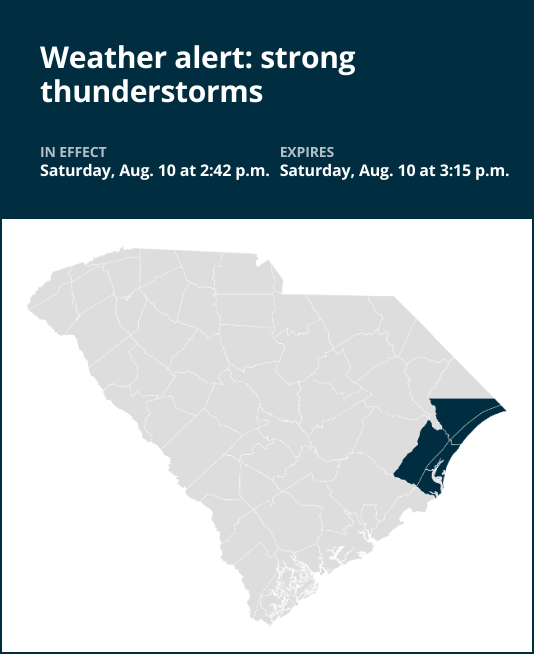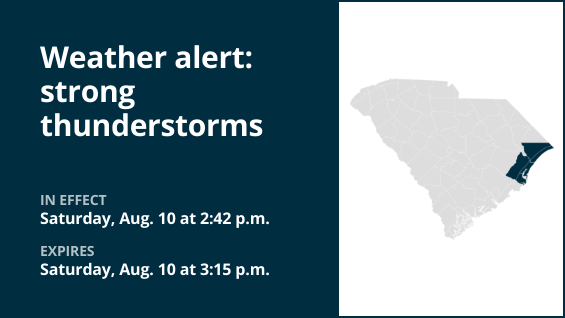The National Weather Service issued a weather alert at 2:42 p.m. on Saturday for strong thunderstorms until 3:15 p.m. for Horry and Georgetown counties.
Residents can be ready for wind gusts of up to 40 mph.
“At 2:40 p.m., Doppler radar tracked a strong thunderstorm over Bucksport, or near Socastee. This thunderstorm was nearly stationary. Additional thunderstorms will develop and are capable to produce very heavy rain and lightning,” according to the weather service. “Gusty winds and very heavy rains.”
Locations impacted by the alert include Myrtle Beach, Conway, Socastee, Red Hill, Murrells Inlet, Garden City, Myrtle Beach Airport, Hickory Grove, Burgess, Horry Georgetown Technical College Conway Campus, Bucksville, Hand, Nixonville, Barefoot Landing Area Of North Myrtle Beach, Bucksport, Dongola, Forestbrook, Yauhannah, Coastal Carolina University and Briarcliffe Acres. This includes the following highways: SC Highway 31 between mile markers 5 and 18. SC Highway 22 between mile markers 14 and 16, and between mile markers 21 and 26.
The weather service comments, “If outdoors, consider seeking shelter inside a building. Torrential rainfall is also occurring with this storm and may lead to localized flooding. Do not drive your vehicle through flooded roadways. Continuous cloud to ground lightning is occurring with this storm. Move indoors immediately. Lightning is one of nature’s leading killers. Remember, if you can hear thunder, you are close enough to be struck by lightning.”
This alert is in effect until 3:15 p.m.

Shielding yourself from approaching lightning: Expert safety guidelines
Lightning strikes the United States approximately 25 million times each year, with the bulk of these electrical discharges occurring during the summer months. Tragically, lightning claims the lives of about 20 individuals annually, as reported by the weather service. The risk of lightning-related incidents escalates as thunderstorms draw near, reaching its peak when the storm directly looms overhead. However, it gradually recedes as the tempest moves away.
To ensure your safety during a thunderstorm, keep these recommendations in mind:
Lightning safety plan:When venturing outdoors, it’s crucial to have a lightning safety plan in place.
Monitor the sky for threatening signs and listen for the sound of thunder. If thunder is audible, it’s an indication that lightning is nearby.
Seek a safe place to shelter, preferably indoors.
Indoors safety measures:Once you’re indoors, avoid using corded phones, electrical devices, plumbing fixtures, and stay away from windows and doors.
These precautions help reduce the risk of electrical surges, as lightning can follow conductive pathways.
Wait for the all-clear:After the last lightning strike or thunderclap, wait at least 30 minutes before resuming outdoor activities.
Lightning can strike even when a storm has seemingly passed, so exercise caution.
When indoor shelter isn’t available:If you find yourself outdoors with no access to indoor shelter during a thunderstorm, take these steps to maximize your safety:
Avoid open fields, hilltops, or ridge crests, which expose you to greater lightning risk.
Steer clear of tall, isolated trees and other prominent objects. In forested areas, stay close to lower stands of trees.
If you’re in a group, ensure that individuals are spaced out to prevent lightning current from transferring between people.
Camping in an open setting during a thunderstorm is strongly discouraged. If no alternative exists, set up camp in a valley, ravine, or other low-lying areas. Remember that a tent offers no protection against lightning.
Do not approach water bodies, wet objects, or metal items. While water and metal don’t attract lightning, they conduct electricity effectively and can pose significant risks.
In summary, when facing the threat of lightning, preparedness and vigilance are your best allies. By following these guidelines, you can significantly reduce the likelihood of lightning-related incidents and prioritize your safety.
Driving through downpours: Safety guidelines for wet roads
When heavy rain sets in, the risk of flooding and hazardous driving conditions rises. Whether it’s prolonged rainfall or rapid runoff, being prepared is essential. Here are some valuable safety tips from the weather service to ensure you stay safe in heavy rain:
Beware of swollen waterways:Avoid parking or walking in close proximity to culverts or drainage ditches, as the swiftly moving water during heavy rain can potentially carry you away.
Maintain safe driving distances:Adhere to the two-second rule for maintaining a safe following distance behind the vehicle in front of you. In heavy rain, allow an additional two seconds of distance to compensate for reduced traction and braking effectiveness.
Slow down and stay cautious:If it is raining and the roads are wet, slow down. Take your foot off the accelerator and let your speed drop gradually. Never use the brakes suddenly because this may cause the car to skid.
Choose your lane wisely:Stay toward the middle lanes – water tends to pool in the outside lanes.
Prioritize visibilityTurn on your headlights and be careful of other vehicles to the rear and in blind spot areas as they are especially difficult to see through rain-spattered windows.
Watch out for slippery roads:The initial half-hour of rain is when roads are slickest due to a mixture of rain, grime, and oil. Exercise heightened caution during this period.
Keep a safe distance from large vehicles:Don’t follow large trucks or buses too closely. The spray created by their large tires reduces your vision. Take care when passing them as well; if you must pass, do so quickly and safely.
Mind your windshield wipers:Heavy rain can overload the wiper blades. When visibility is so limited that the edges of the road or other vehicles cannot be seen at a safe distance, it is time to pull over and wait for the rain to ease up. It is best to stop at rest areas or other protected areas.
When stopping by the roadside is your only option, position your vehicle as far off the road as possible, ideally beyond guardrails. Keep your headlights on and activate emergency flashers to alert other drivers of your position.
In the face of heavy rain, these precautions can make a significant difference in ensuring your safety on the road. Remember to stay informed about weather conditions and heed guidance from local authorities for a secure journey.






